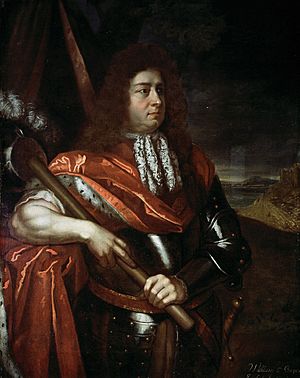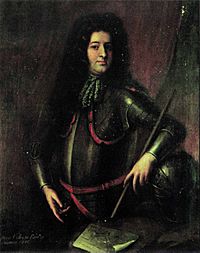William O'Brien, 2nd Earl of Inchiquin facts for kids
Quick facts for kids
The Earl of Inchiquin
PC
|
|
|---|---|
 |
|
| Governor of Tangier | |
| In office 1675–1680 |
|
| Monarch | Charles II |
| Preceded by | Earl of Middleton |
| Succeeded by | Sir Palmes Fairborne |
| Governor of Jamaica | |
| In office 1690–1692 |
|
| Monarch | James II |
| Preceded by | Francis Watson |
| Succeeded by | John White |
| Personal details | |
| Born | c. 1640 Doneraile, County Cork |
| Died | January 16, 1692 (aged 51–52) Spanish Town, Jamaica |
| Spouses | Lady Margaret Boyle (m. 1665) Lady Elizabeth Brydges (m. 1684) |
| Children | 4, including William |
| Military service | |
| Allegiance | (1659–1660) (1674–1680) |
| Branch/service | (1659–1660) (1674–1680) |
| Rank | Colonel |
| Unit | Tangier Regiment |
| Battles/wars | Williamite War in Ireland |
William O'Brien, 2nd Earl of Inchiquin (born around 1640 – died 16 January 1692), was an Irish military officer and nobleman. He served as a colonial administrator for the English Crown. He was the governor of Tangier from 1675 to 1680. Later, he became the governor of Jamaica from 1690 until his death in 1692.
William O'Brien was born in Doneraile, County Cork, Ireland, around 1640. He grew up in London. In 1659, he joined the French Royal Army with his father. In 1660, pirates captured him and held him for a year in North Africa. After being freed, he returned to England.
In 1671, O'Brien joined the Privy Council of Ireland, a group of royal advisors. He became governor of Tangier in 1674. However, his time as governor was not very successful, and he was called back to England in 1680. When King James II became king in 1685, O'Brien lost his position on the Privy Council. During the Glorious Revolution of 1688, he supported the new King William III.
O'Brien was appointed governor of Jamaica in 1689. He started this role a year later. As governor, he often disagreed with the local assembly about money. He also helped restart the justice system and stopped a rebellion by enslaved people. He died in Jamaica in 1692 from an illness.
Contents
Early Life and Adventures
William O'Brien was born around 1640 in Doneraile, a town in County Cork, Ireland. His father was Murrough O'Brien, 1st Earl of Inchiquin, a military officer and nobleman. William's mother was Elizabeth St Leger. William grew up in London at the home of his father's friend, Sir Philip Perceval.
In 1648, William was briefly held in the Tower of London. This happened because his father had switched sides in a war and taken some children hostage. In 1652, William visited Ireland without official permission.
After the war ended, William and his father joined the French Royal Army in 1659. In February 1660, while on a French ship, they were captured by pirates. His father was soon freed, but William was held for a year. He was released after King Charles II paid a ransom for him. After this, William returned to England.
Serving in Tangier
In 1671, O'Brien became a member of the Privy Council of Ireland. This was a group of important advisors to the king in Ireland. Three years later, in 1674, he was chosen to be the governor of English Tangier. Tangier was an English outpost in North Africa. He also became a colonel in the English Army.
As governor, O'Brien did not show strong military skills. In 1675, he sent a large group of soldiers to raid for cattle. This raid went badly, and 150 English soldiers were hurt or killed.
Because of his poor performance, O'Brien was called back to England in 1680. He was replaced as governor by Sir Palmes Fairborne. O'Brien had often been away from Tangier after the failed cattle raid. When he returned to England, he gave King Charles II two North African ostriches to try and make up for his mistakes.
Political Changes and War
When King James II became king in 1685, O'Brien lost his position on the Irish Privy Council. During the Glorious Revolution of 1688, O'Brien supported the side of King William III. In early 1689, O'Brien fought in Munster, Ireland. He fought alongside Protestant families against Irish soldiers who supported King James II.
However, O'Brien's troops were defeated by a general loyal to King James II. Despite the defeat, O'Brien was allowed to leave for England with a lot of money. This was against King James II's wishes.
Soon after arriving in England, O'Brien was named in a special law called "The Great Act of Attainder." This law was passed by King James II to punish his political opponents. While in London, O'Brien met King William III and offered his help. In September 1689, King William III appointed O'Brien as the governor of Jamaica. O'Brien arrived on the island on May 31, 1690, with his wife and son.
Governing Jamaica
William O'Brien's time as governor of Jamaica was challenging. He worked to restart the justice system in Jamaica, which had stopped working in 1688. He also personally stopped a rebellion by about 500 enslaved Africans on a large farm in Jamaica.
By 1691, Jamaica was sending a lot of money, about 100,000 pounds, to England each year. O'Brien was worried about a possible attack from the French. He asked England for Royal Navy warships to protect Jamaica. He also created a small navy of his own using five small ships and one captured ship. This was to fight against French ships from a nearby colony.
O'Brien often disagreed with the Jamaican governor's council. He described the council members as "troublesome and harmful advisors."
While in Jamaica, O'Brien gained a personal fortune of 15,000 pounds. Some people at the time said this money came partly from his involvement in the profitable slave trade. He also supported the Jewish community in Jamaica. He allowed them to trade in the colony on the same terms as other merchants. Many English merchants in Jamaica did not like this. After O'Brien's death, they tried to change this policy.
In August 1691, O'Brien closed the Jamaican House of Assembly. He said its members were trying to weaken his power and take away his income. During their meeting, the assembly rejected his idea for a land tax. He also refused to support a tax on the slave trade that the assembly proposed.
By this time, O'Brien's health was getting worse. He asked for permission to return to England. On January 16, 1692, O'Brien died in Spanish Town from an illness called "bloody flux" (dysentery). He was buried in the local church.
After his death, other people temporarily took over as governor. King William III had chosen O'Brien to be governor. However, O'Brien was not popular among the wealthy plantation owners in Jamaica. Because of this, the king later appointed William Beeston, a rich plantation owner, as the new governor.
Family Life
William O'Brien was married twice. His first marriage was to Lady Margaret Boyle in December 1665. They had four children together, including a son named William. Margaret passed away in December 1683. His second wife was Lady Elizabeth Brydges, whom he married in 1684. They did not have any children together.
After his father died in 1674, O'Brien inherited his father's title as the Earl of Inchiquin. He also gained control of his father's large estate, which included 60,000 acres of land and Rostellan Castle. Even with this valuable estate, O'Brien often had debts. He tried to arrange a marriage for his son William to a rich merchant's daughter to help with money, but it did not work out.
After O'Brien died in 1692, his son William became the next Earl of Inchiquin. William also faced money problems throughout his life.
In Jamaica, people had different opinions about O'Brien's time as governor after he died. One political opponent said that O'Brien gained too much money too quickly. However, O'Brien's personal secretary disagreed. He said that the very people O'Brien had helped were now trying to make him look bad.


